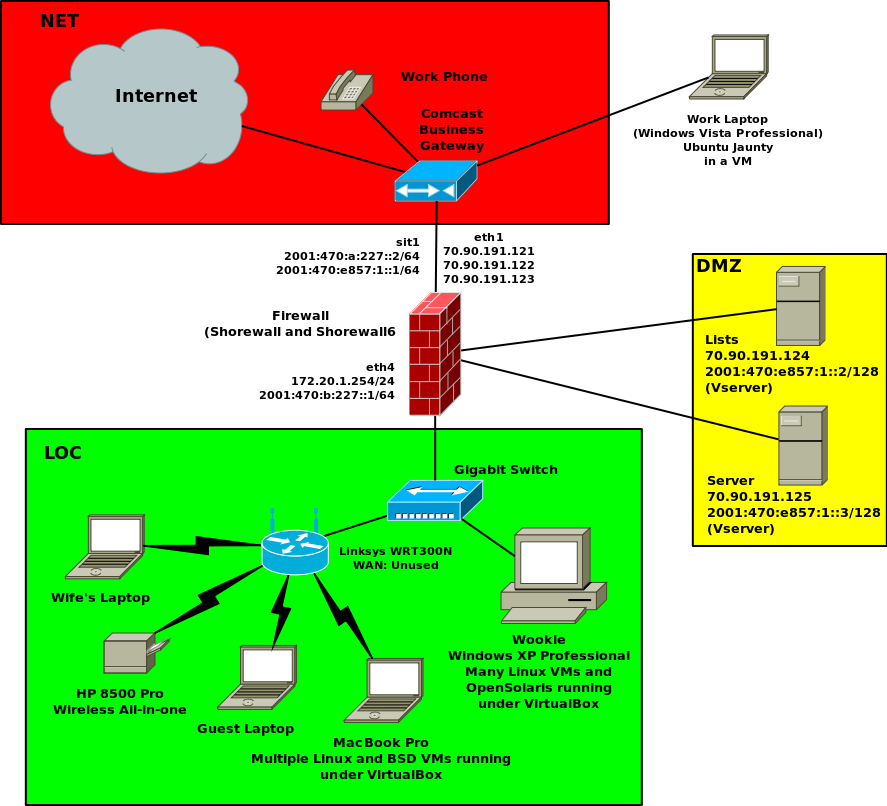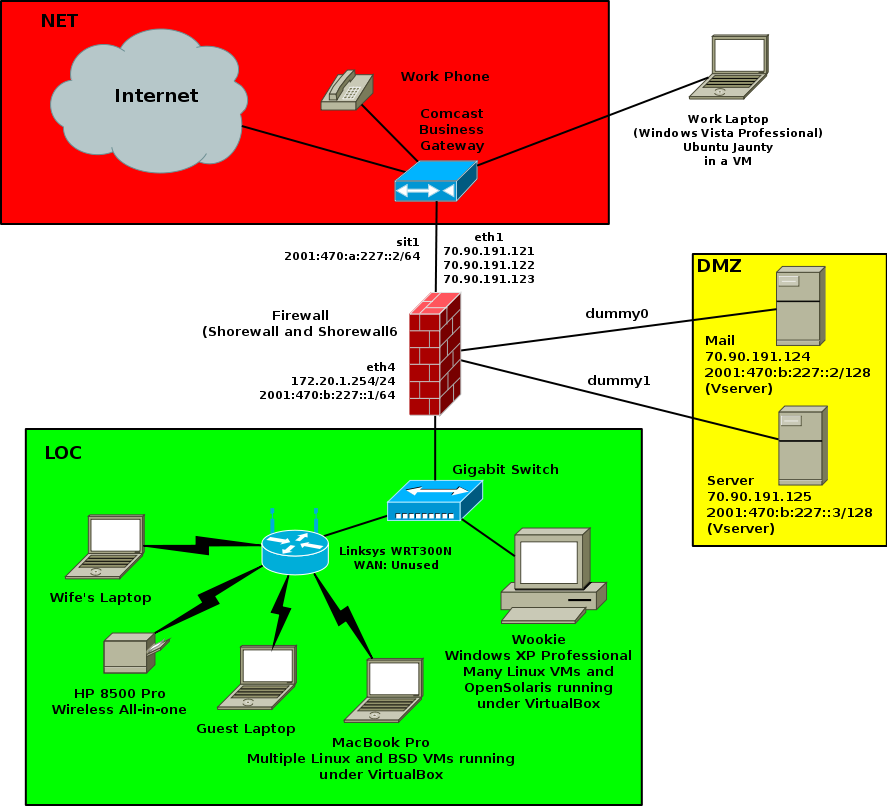Copyright © 2010 Thomas M. Eastep
Permission is granted to copy, distribute and/or modify this document under the terms of the GNU Free Documentation License, Version 1.2 or any later version published by the Free Software Foundation; with no Invariant Sections, with no Front-Cover, and with no Back-Cover Texts. A copy of the license is included in the section entitled “GNU Free Documentation License”.
2020/02/16
Formal support for Linux-vserver was added in Shorewall 4.4.11 Beta2. The centerpiece of that support is the vserver zone type. Vserver zones have the following characteristics:
They are defined on the Linux-vserver host.
The $FW zone is their implicit parent.
Their contents must be defined using the shorewall-hosts (5) file. The ipsec option may not be specified.
They may not appear in the ZONE column of the shorewall-interfaces (5) file.
Note that you don't need to run Vservers to use vserver zones; they may also be used to create a firewall sub-zone for each aliased interface.
If you use these zones, keep in mind that Linux-vserver implements a very weak form of network virtualization:
From a networking point of view, vservers live on the host system. So if you don't use care, Vserver traffic to/from zone z will be controlled by the fw->z and z->fw rules and policies rather than by vserver->z and z->vserver rules and policies.
Outgoing connections from a vserver will not use the Vserver's address as the SOURCE IP address unless you configure applications running in the Vserver properly. This is especially true for IPv6 applications. Such connections will appear to come from the $FW zone rather than the intended Vserver zone.
While you can define the vservers to be associated with the network interface where their IP addresses are added at vserver startup time, Shorewall internally associates all vservers with the loopback interface (lo). Here's an example of how that association can show up:
gateway:~# shorewall show zones Shorewall 4.4.11-Beta2 Zones at gateway - Fri Jul 2 12:26:30 PDT 2010 fw (firewall) drct (ipv4) eth4:+drct_eth4 loc (ipv4) eth4:0.0.0.0/0 net (ipv4) eth1:0.0.0.0/0 vpn (ipv4) tun+:0.0.0.0/0 dmz (vserver) lo:70.90.191.124/31 gateway:~#
This is a diagram of the network configuration here at Shorewall.net during the summer of 2010:

I created a zone for the vservers as follows:
/etc/shorewall/zones:
#ZONE TYPE OPTIONS ...
fw firewall
loc ip #Local Zone
drct:loc ipv4 #Direct internet access
net ipv4 #Internet
vpn ipv4 #OpenVPN clients
dmz vserver #Vservers/etc/shorewall/interfaces:
?FORMAT 2
#ZONE INTERFACE OPTIONS
net eth1 routeback,dhcp,optional,routefilter=0,logmartians,proxyarp=0,nosmurfs,upnp
.../etc/shorewall/hosts:
#ZONE HOST(S) OPTIONS
drct eth4:dynamic
dmz eth1:70.90.191.124/31 routebackWhile the IP addresses 70.90.191.124 and 70.90.191.125 are configured on eth1, the actual interface name is irrelevant so long as the interface is defined in shorewall-interfaces (5). Shorewall will consider all vserver zones to be associated with the loopback interface (lo). Note that the routeback option is required if the vservers are to be able to communicate with each other.
Once a vserver zone is defined, it can be used like any other zone type.
Here is the corresponding IPv6 configuration.
/etc/shorewall6/zones
#ZONE TYPE OPTIONS IN_OPTIONS OUT_OPTIONS
fw firewall
net ipv6
loc ipv6
vpn ipv6
dmz vserver
/etc/shorewall6/interfaces:
?FORMAT 2
#ZONE INTERFACE OPTIONS
net sit1 tcpflags,forward=1,nosmurfs,routeback
.../etc/shorewall6/hosts:
#ZONE HOST(S) OPTIONS
dmz sit1:[2001:470:e857:1::/64]Note that I choose to place the Vservers on sit1 (the IPv6 net interface) rather than on eth1. Again, it really doesn't matter much.
I have both a /64 (2001:470:b:227::/64) and a /48 (2001:470:e857::/48) from Hurricane Electric. When I first set up my Vserver configuration, I assigned addresses from the /48 to the Vservers as shown above.
Given that it is likely that when native IPv6 is available from my ISP, I will only be able to afford a single /64, in February 2011 I decided to migrate my vservers to the /64. This was possible because of Proxy NDP support in Shorewall 4.4.16 and later. The new network diagram is as shown below:

This change was accompanied by the following additions to
/etc/shorewall6/proxyndp:
#ADDRESS INTERFACE EXTERNAL HAVEROUTE PERSISTENT 2001:470:b:227::2 - eth4 Yes Yes 2001:470:b:227::3 - eth4 Yes Yes
These two entries allow the firewall to respond to NDP requests for the two Vserver IPv6 addresses received on interface eth4.
As part of this change, the Lists vserver (OpenSuSE 10.3 was retired in favor of Mail (Debian Squeeze).

